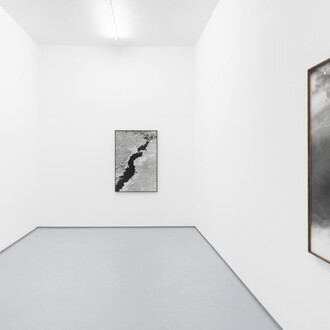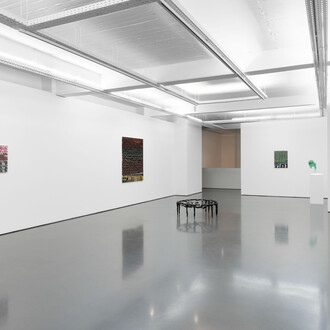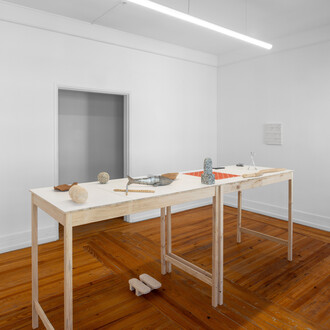Madragoa is delighted to present Antes, despues, ayer, mientras, ahora, the second solo exhibition by Belén Uriel at the gallery.
To the back cover of View Magazine (March ‘45 issue), Duchamp consigned his enigmatic notion of “inframince,” a neologism that, he stated, could not be defned, but only illustrated through examples: “When the tobacco smoke smells also of the mouth which exhales it, the 2 odors marry by the infra-thin”.
The new group of sculptures by Uriel, which represent a continuation of her research project on the mutuality between the human body and some objects of everyday use, could be considered one of the examples able to illustrate the slippery concept of inframince.
The subject of her investigation in this new production is a canvas rucksack of a common type, a neutral, featureless accessory, devoid of remarkable details, whose adjectivisation can only refer to its use value: an object so familiar and ordinary that it becomes almost invisible. The rucksack became the matrix for different series of works; the artist studied its anatomy and dissected it, isolating its constituent parts or sectioning portions – the zip, the shoulder straps, the backrest – which are casted and translated into different materials: glass, bronze, and a particular alloy of plaster and bronze developed by Uriel.
In Quechas fve glass profles of the rucksack, seen from the side, hang from a metal structure built according to the proportions of the human body; they are placed at different heights, simulating the different positions an actual rucksack can assume in the space in relation to the body that wears and uses it. With its circular display, the sculpture replicates the torsion, the rotational movement implicit in the gesture of taking the rucksack off the shoulders, visualising it in a sequence of fve freeze-frames. Even if the glass faithfully reproduces the object, the fragmentary nature of the pieces prevents viewers from instant identifcation, except for a few clues, such as pockets and seams; their organic and hollow form rather evokes that of carapaces, shells, lungs, or empty cocoons.
Similar display and choreography are the basis of S,M,L, a sculpture consisting of a metal skeleton from which four straps hang, they are casts made of the alloy of plaster and bronze, whose profle reproduces the soft curve of the shoulders.
From the gallery wall, a piece of a chair armrest casted in glass stretches out, turned into a hanger to support the rucksack seams profle or a elbow pad both, in bronze; while the backrest of the rucksack shows its internal side, usually invisible, turned inside out, restoring the shape of the human back to which it usually adheres, a result that turns out to be similar to a classic torso.
Black drop is a series of small all-round sculptures, each one composed by the side profles of the rucksack casted in glazed glass and paired, as to reconstitute the shape of a shell with its two hollow valves. They are placed on a low base constituted by different types of seats, such as a saddle or stool, also casted in glass or metal.
A dark color, almost black, or tending to green and grey, dominates the exhibition, as if to emphasise the neutrality of everyday objects that must not attract attention, never tire the eye nor go out of fashion. The colour, that gives more heaviness to the sculptures, also refers to the idea of armor, cuirass, shield, the personal protective equipment designed to ft and protect the human body.
The conceptual core of the exhibition lies in the convergence of human body, object and its daily use: The reciprocal nature of the relationship between body and the object, the epidermal contact that allows one to adapt to and shape the other, that “infrathin” point where one ends and the other begins. The idea of the body imprint preserved in the object is perpetrated in the making of the sculptures through the mould. The body seems to have infused into the object a living feature, the sculptures’ shape, although rigid in the glass or bronze, is anthropomorphic, organic.
The sequence of adverbs of the exhibition title – a line borrowed from Borges – trying to circumscribe and grasp the time, which becomes thinner and thinner towards the present, reaffrms the power of everyday routine to make changes invisible.
Belén Uriel (Madrid, Spain, 1974) lives and works between Lisbon and London.
Her most recent solo exhibitions include: ‘Bonança’, CA2M, Madrid, 2019, ‘Qualia’, Sismógrafo, Oporto; ‘Descanso’, Madragoa, Lisbon, 2017, ‘Topázio’, Gabinete, Lisboa, 2017; ‘segunda-feira’, Culturgest, Lisboa, 2016; ‘Sand, Paper, Scissors’, Projektraum Museum, Wiesbaden, 2016. Recent group exhibitions include: ‘The Third Bank’, Bienal Ano Zero, Coimbra, 2019; Sala de Arte Santander, Fundación Santander, Madrid, 2019; ‘Tandem: Gabriel Abrantes and Belén Uriel’, Alexander and Bonin, 2019; Estudos do Labirinto, Museo da Marinha, Lisbon, 2018; ‘Vacío Perfecto’, MUSAC, León, 2017; ‘Art en Transit’, Muxart, Espai d’Art i Creación Contemporanis, Martorell, 2016; ‘Art en Trànsit’, Cerdanyola Art Museum, Barcelona, 2015; ‘Drawing Biennial 2015’, Drawing Room, Londres, 2015.
She was awarded the Programa de Apoio ás Artes Visuais Calouste Gulbenkian Foundation, Lisbon, 2015, the Art and Research Motehermoso, Montehermoso Contemporary Art Centre, Vitoria, 2011, and the 6th Edition of the MUSAC Artistic Creation Grants MUSAC, León, 2010-11; Matadero Contemporary Art Creation Grants, Matadero Art Centre, Madrid, 2010.
















